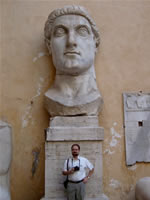
| Campus | Tarpon Springs Campus |
| Location | LY N/A |
| Title | Adjunct Faculty |
| Email | Underwood.David@spcollege.edu |
| Phone | n/a |
MY PHILOSOPHY OF TEACHING
David K. Underwood, Ph.D.
My teaching philosophy has developed from a number of teaching-learning experiences I have had over the past two decades. It stresses the implementation of a series of practices I have found to be effective. I believe that teaching should focus on and maximize the "engaged" or "active" learning process. Meaningful learning is intensified when instruction fosters various experiential dimensions in the classroom. A major goal of good teaching is to get students involved on a direct and personal level in the material, thereby making the learning experience active rather than passive. This goal can be achieved through attending to and promoting the following six dimensions of "engaged" teaching/learning:
1) interdisciplinary and multimedia approaches; 2) interactive learning; 3) "informal" writing; 4) individual focus; 5) improvisation; 6) integration and contextualization.
In the humanities classroom, interdisciplinary and multimedia approaches are fostered when traditional book and slide media are supplemented by films, videos, field-trips, lectures, performances, and the like. Instruction borrows techniques from theater arts (role playing); debating teams (position papers); writing workshops and studio criticisms (peer critiques); symposia and exhibitions. Instruction stresses the interconnections among disciplines whenever possible. Interactive learning is promoted when communications flow both vertically (between student and instructor) and horizontally (among students). I use group work, group discussion, and peer review extensively, and often tie these in effectively with informal writing exercises in the form of various kinds of journal assignments. The journal is also a major means by which learning can be personalized– a place in which the individual student makes the course material his or her own. I encourage students to use the journal in a number of ways–to record thoughts about a reading, to respond to a work of art, to jot down notes from a classmate’s presentation, etc. Whenever possible, teaching should be tailored to the students’ individual interests and learning styles, and should be open to learning from and working with the group dynamic of a given classroom situation. This means that instruction needs to be flexible and open to different situations and improvisation. This is not to say that the syllabus should not be well structured and closely followed, just that instruction should be open to the spontaneous wonder of learning. An instructor who is glued to lecture notes and afraid to try new things runs the risk of boring everyone to tears, putting everyone to sleep, and sabotaging the learning process. Finally, instruction should, whenever possible, integrate the lessons of the classroom with the world beyond it by promoting an awareness of the multiple contexts in which we live. Good teaching brings out the broader implications and ramifications of the material studied, and fosters connections among our classroom concerns and those of the campus, the community, the nation, the world, and the universe. Good teaching ultimately promotes ethical standards, spiritual awareness, and a sense of social and political responsibility.